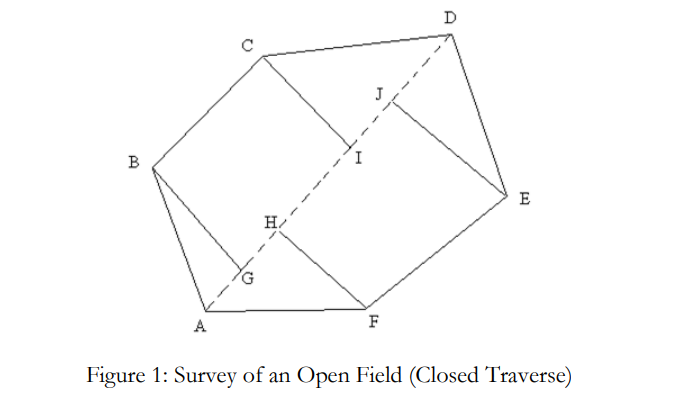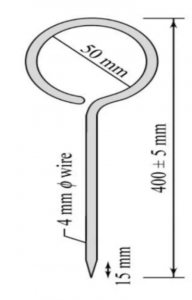Table of Contents
Chain Survey:
One of the most basic types of field survey is Chain surveying. It is the method in which only the horizontal measurements are essential to draw the land on paper. The measurement of just the linear distances makes it a relatively easy method that uses minimum instruments, with no angle measuring instrument required.

The whole area is divided into triangles and the measurement of a triangle’s three sides gives the position of area details, called Triangulation.
AD is the Baseline
AB, BC, CD, DE, EF, FA are Main Survey Lines
BG, HF, IC, EJ are Perpendicular Offsets
Chain Survey Instruments:
The measurement of just the linear distance is needed in chain surveying. This makes the chain or tape the basic instruments. The following are among the most important instruments which are used in Chain surveying:
- Chain
- Arrows
- Pegs
- Ranging rods
- Offset rods
- Plaster’s laths and whites
- Plumb bob
Now the instruments mentioned above will be discussed in detail separately.
1)Chain:
Chain is the most basic and vital instrument used for chain surveying. It is used to measure the required lengths of horizontal distances on the field.
A Chain is comprised of straight steel links with hooks at the end, which are interconnected by three steel rings. Proper brass handles are attached at both ends of the chain which help to carry and hold it with ease.
Apart from this arrangement, brass tags or tallies are also attached at different locations on the chain to indicate the particular distance covered by the chain till that point.
Types of Chains:
There are different types of chains available in the market, depending upon the type of measurement unit and the total length of the chain. The following are some of the important types of chains used:
a)Metric Chain:
The unit of measurement is Metric and the total length is 20m and 30m is available. Brass rings are kept at a distance of every meter and tallies are hung after every five meters, as shown in the picture down below;
b)Gunter’s Chain:
The unit of measurement is Feet and the total length is 66’. Brass rings are kept at a distance of about 0.66’.
c)Engineer’s Chain:
The unit of measurement is Feet and the total length is 100’. Brass rings are kept at a distance of 1’ and a tally is attached at every 10’.
2)Arrows:
After measuring the length of any line on the ground, arrows are used to mark the endpoints of the chain, in case the line to be measured is more than the chain length. When the arrows are inserted in the ground, the point is accurately marked and reduces the possibility of any error.
It is made up of steel wire, with one end pointed which is to be embedded in the ground. While the other end is bent in a circle, for the ease of carrying it. Generally, a chain is provided with 10 arrows to mark its points. An arrow is usually of 4mm diameter with the vertical length of about 4cm, as shown in the picture down below;
2)Pegs:
Pegs are conical-shaped small blocks, made of timber. They are tapered at both ends. Whenever a station point or terminal point is to be marked on the ground, a peg is hammered inside the ground.
The cross-section of a peg is usually a square of about 2.5cm or 3cm widths, while its vertical length is 15cm out of which 4cm must be kept out of the ground.
3)Ranging rods:
Ranging rods are straight timber poles hexagonal in shape, which are covered with heavy iron at the bottom. This metal shoe at the bottom is pointed so that it can be driven into the ground and can stand straight without any problem. The rod is painted with alternate-colored bands, as white and red showed in the picture.
This helps to easily see the rod from a long distance. Ranging rods are used to mark the intermediate points inside a straight line.
The diameter of the rod is about 3cm and rods of length 2m or 3m are available. Each band is 20cm in length on the rod.
4)Offset rods:
Offset rods are similar to the ranging rods in their shape and formation. Additionally, it has a hook at the top to easily drag it to the location. Also, it has narrow slots in the middle, which helps in aligning the rod correctly. Offset rod is therefore used to roughly measure the length of a line or align the points.
5)Laths and Whites:
When the number of ranging rods is limited, laths or whites are used to mark the intermediate points in the line.
-
Laths:
These are sticks made up of wood. Its one end is pointed to inserted in the ground, while the other is painted with a color that can be easily recognized from a distance, like red. Its length is about half or one meter long but can vary according to the need.
-
Whites:
These are rather thicker sticks as compared to laths. They are pointed at one end and are split at the other end. The end which is split is used to insert a piece of paper, to make it identifiable on the ground.

6)Plumb bob:
A Plumb bob is simply a heavy metal bob connected at one end of the string. When the free end of the Plumb bob is held at a certain height, it hangs vertically downwards due to its weight.
During the survey of an area that has some sloping ground, the plumb bob is used. It transfers the points at the surface level without errors and very easily. It can also be used to straighten the rods which are to be embedded in the ground.
Conclusion:
This report explains some of the basic instruments which are required by any type of Chain surveying. Although some other instruments are also introduced in the field to increase the efficiency of the process in the minimum required time. For example, Optica Square.














